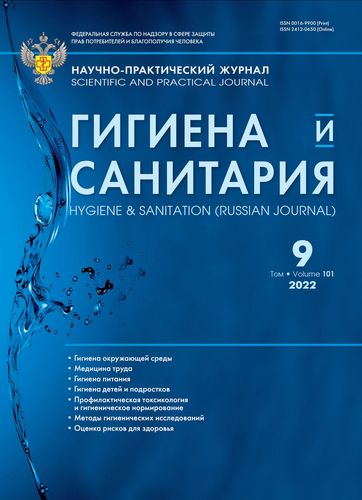Risk of low back pain among Indonesian volcano sulfur miners: a retrospective cohort study
- Авторлар: Akbar K.A.1
-
Мекемелер:
- Jember University
- Шығарылым: Том 101, № 9 (2022)
- Беттер: 1054-1057
- Бөлім: OCCUPATIONAL HEALTH
- ##submission.datePublished##: 08.10.2022
- URL: https://archivog.com/0016-9900/article/view/638967
- DOI: https://doi.org/10.47470/0016-9900-2022-101-9-1054-1057
- ID: 638967
Дәйексөз келтіру
Толық мәтін
Аннотация
Introduction. Kawah Ijen is the main volcano sulfur-producing in Indonesia. There is still a lot of conventional Sulfur mining going on there. Every day, Sulfur miners work walking about 8.5 km to transport Sulfur weighing 70–100 kilograms using simple transporters that are only held on one shoulder to the Sulfur collection site. The health problem that is the focus of this study is the incidence of low back pain (LBP) in volcano sulfur miners.
Aims and objectives. This study aims to determine the magnitude of the risk of low back pain in sulfur miners to prevent occupational diseases.
Materials and methods. This research was carried out for three months. This study adopted a retrospective cohort study design. The research sample amounted to 140 respondents taken by simple random sampling. The data collection technique was carried out by interview and lasegue test and Patrick’s test to see the respondents’ positive or negative of low back pain. Data analysis was carried out using rank spearmen test.
Results. The results showed a relationship between the incidence of low back pain in the community and work (p-value < 0.000). Indonesian volcano sulfur miners are 5,032 times more at risk of low back pain than other public workers.
Conclusion. Volcano Sulfur Miners are more at risk of experiencing low back pain than other occupations.
Conflict of interest: the authors declare no conflict of interest.
Acknowledgment: this study was conducted with support from the Public health faculty, Jember University and Airlangga University, Indonesia.
Received: March 29, 2022 / Accepted: August 04, 2022 / Published: September 30, 2022
Негізгі сөздер
Авторлар туралы
Kurnia Akbar
Jember University
Хат алмасуға жауапты Автор.
Email: ardiansyah_akbar@unej.ac.id
ORCID iD: 0000-0001-6265-3064
Faculty of Public Health, Jember University, Jl. Kalimantan No. 42, Krajan Timur, Sumbersari, Kec. Sumbersari, Jember District, East Java, 68121 Indonesia.
e-mail: ardiansyah_akbar@unej.ac.id
ИндонезияӘдебиет тізімі
- Hidayat A., Marfai M.A., Hadmoko D.S. Eruption on Indonesia’s volcanic islands: A review of potential hazards, fatalities, and management. IOP Conf. Ser. Earth Environ. Sci. 2020; 485(1): 012061.
- Zaennudin A. The characteristic of eruption of Indonesian active volcanoes in the last four decades. J. Lingkung dan Bencana Geol. 2010; 1(2): 113-29.
- Caudron C., Syahbana D.K., Lecocq T., Van Hinsberg V., McCausland W., Triantafyllou A., et al. Kawah Ijen volcanic activity: a review. Bull. Volcanol. 2015; 77(3): 1-39. https://doi.org/10.1007/s00445-014-0885-8
- Gupta A.K., Nicol K. The use of sulfur in dermatology. J. Drugs Dermatol. 2004; 3(4): 427-31.
- Sumarti S., Zaenudin A. Formasi danau sangat asam kawah ijen, jawa timur. In: Proceeding, Seminar Nasional Kebumian Ke-10. Yogyakarta; 2017.
- Delmelle P., Bernard A., Kusakabe M., Fischer T.P., Takano B. Geochemistry of the magmatic-hydrothermal system of Kawah Ijen volcano, East Java, Indonesia. J. Volcanol. Geoth. Res. 2000; 97(1-4): 31-53. https://doi.org/10.1016/S0377-0273(99)00158-4
- Setiadji W., Artaria D.M. The traditional way in preventing and overcoming health problems among sulfur miners in the craters of Ijen. In: Implementation of Climate Change Agreement to Meet Sustainable Development Goals. Paris: Atlantis Press; 2018.
- Löhr A.J., Bogaard T.A., Heikens A., Hendriks M.R., Sumarti S., Van Bergen M.J., et al. Natural pollution caused by the extremely acidic crater lake Kawah Ijen, East Java, Indonesia. Environ. Sci. Pollut. Res. 2005; 12(2): 89-95. https://doi.org/10.1065/espr2004.09.118
- Efiyanti A.Y., Fatimah A. Towards family economic sustainability: the transformation of traditional sulphur miners in Ijen crater. Psychol. Educ. 2021; 58(1): 1270-6.
- Urits I., Burshtein A., Sharma M., Testa L., Gold P.A., Orhurhu V., et al. Low back pain, a comprehensive review: pathophysiology, diagnosis, and treatment. Curr. Pain Headache Rep. 2019; 23(3): 23. https://doi.org/10.1007/s11916-019-0757-1
- Meucci R.D., Fassa A.G., Xavier Faria N.M. Prevalence of chronic low back pain: Systematic review. Rev. Saude Publica. 2015; 49: 1.
- Kamath S.U., Kamath S.S. Lasègue’s sign. J. Clin. Diagn. Res. 2017; 11(5): RG01-2. https://doi.org/10.7860/jcdr/2017/24899.9794
- Devillé W.L., van der Windt D.A., Dzaferagić A., Bezemer P.D., Bouter L.M. The Test of Lasègue: systematic review of the accuracy in diagnosing herniated discs. Spine (Phila Pa 1976). 2000; 25(9): 1140-7. https://doi.org/10.1097/00007632-200005010-00016
- Ross M.D., Nordeen M.H., Barido M. Test-retest reliability of Patrick’s hip range of motion test in healthy college-aged men. J. Strength Cond. Res. 2003; 17(1): 156-61. https://doi.org/10.1519/1533-4287(2003)017%3C0156:trroph%3E2.0.co;2
- Jaffar N.A.T., Rahman M.N.A. Review on risk factors related to lower back disorders at workplace. IOP Conf. Ser. Mater. Sci. Eng. 2017; 226(1): 012035.
- Tanaka Y. Epidemiology of low back pain. Clin. Calcium. 2005; 15(3): 35-8. (in Japanese)
- Hoy D., Brooks P., Blyth F., Buchbinder R. The epidemiology of low back pain. Best Pract. Res. Clin. Rheumatol. 2010; 24(6): 769-81. https://doi.org/10.1016/j.berh.2010.10.002
- Jensen O.K., Nielsen C.V., Sørensen J.S., Stengaard-Pedersen K. Back pain was less explained than leg pain: A cross-sectional study using magnetic resonance imaging in low back pain patients with and without radiculopathy Clinical diagnostics and imaging. BMC Musculoskelet. Disord. 2015; 16: 374. https://doi.org/10.1186/s12891-015-0827-4
- Waddell G. The clinical course of back pain. In: The Back Pain Revolution. Edinburg: Churchill Livingstone; 2006.
Қосымша файлдар







